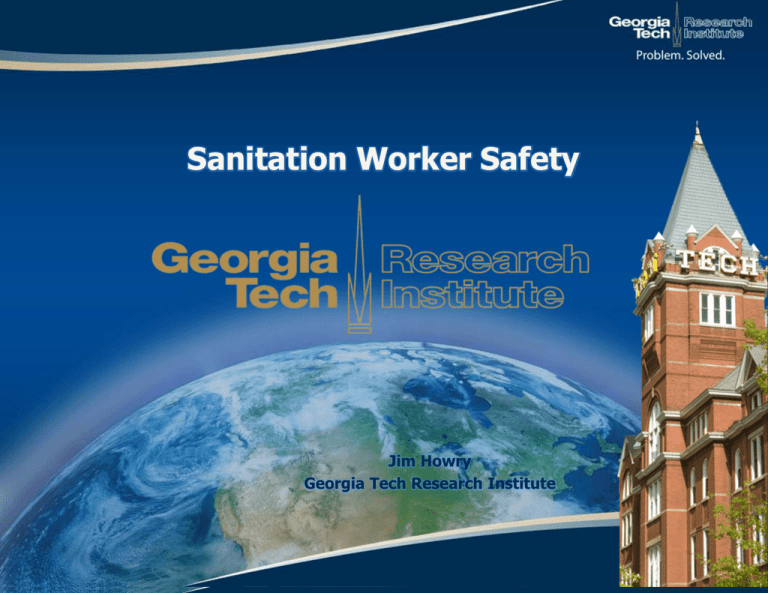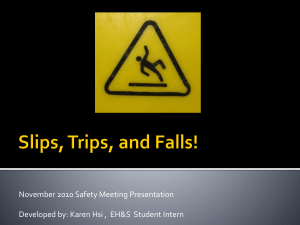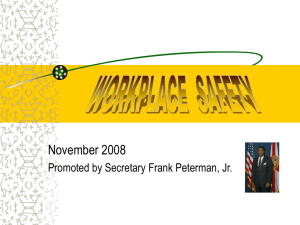Sanitation Worker Safety - American Meat Institute
advertisement

Sanitation Worker Safety Jim Howry Georgia Tech Research Institute 1 What?! 2 Barriers • Time • Turnover • Other Regulatory requirements • i.e. USDA/ FDA/ • Food Safety • Management influence • Square peg syndrome Food Processing Sanitation & Maintenance Worker Safety PD: Jim Howry Organization: GTRI for OSHA Problem statement: Sanitation and maintenance workers in the food processing and poultry industries represent an underserved at risk population. Solution: GTRI conducted research on exposures and developed and delivered targeted occupational safety and health training. Concept: Develop and deliver targeted safety and health curriculum and training. Execution: Trained and equipped 595 trainers who then reached over 20,000 affected workers! Relevance: An underserved population of workers was provided critical training. Timeline: Training conducted October 2007 through October 2010. Current Status: Project is complete. Overall: • 595 Trainers trained! • The total number of employees trained : 25,523 • This curriculum is still available for free on the web and remains in demand. Hazard Analysis • • • • • Slips, Trips & Falls Human Factors Machine Hazards Lockout Tagout Chemical Exposure • Hazcom (GHS) • Personal Protective Equipment • Permit Required Confined Spaces Hazards Specific to Sanitation Workers • Climbing on equipment without proper fall protection • Using ladders on uneven surfaces and/or equipment • Not replacing floor covers causing trip hazards Hazards Specific to Sanitation Workers (continued) • General housekeeping – not returning hoses, tools, ladders, etc. to designated locations • Not wearing appropriate footwear for wet/slippery locations • Rushing around on wet surfaces Definitions • Slip • Too little friction or traction between feet (footware) & walking/working surface, resulting in loss of balance Definitions • Trip • Foot or lower leg hits object & upper body continues moving, resulting in loss of balance • Stepping down to lower surface & losing balance Potential Trip Hazards? Definitions • Fall • Occurs when too far off center of balance • Two types • Fall at same level • Fall to same walking or working surface, or fall into or against objects above same surface • Fall to lower level • Fall to level below walking or working surface Causes of Slips • Wet product or spills on smooth floors or walking surfaces • • • • • • • Water Mud Grease Oil Food Blood Offal Causes of Slips • Dry product or spills making walking surface slippery • • • • • Dusts Powders Granules Wood Plastic wrapping Causes of Slips • Highly-polished floors can be slick even when dry • Concrete • Marble • Ceramic tile • Freshly-waxed surfaces • Transitioning from one surface to another • Carpeted to vinyl • Grid to smooth concrete Causes of Slips • • • • • Sloped walking surfaces Loose, unanchored rugs or mats Loose floorboards or shifting tiles Wet, muddy or greasy shoes Ramps & gang planks without skid- or slip-resistant surfaces Causes of Slips • Metal surfaces • Dockboards & dock plates • Platforms • Sidewalk & road covers • Mounting & dismounting vehicles & equipment • Climbing ladders • Loose, irregular surfaces such as gravel Causes of Slips • Sloped, uneven or muddy terrain • Weather hazards • Leaves, pine needles & other plant debris (wet or dry) Causes of Trips • Uncovered hoses, cables, wires or extension cords across aisles or walkways • Clutter, obstacles in aisles, walkway & work areas • Open cabinet, file or desk drawers & doors Causes of Trips • Changes in elevation or levels • Unmarked steps or ramps • Rumpled or rolled-up carpets/mats or carpets with curled edges • Irregularities in walking surfaces • Thresholds or gaps • Missing or uneven floor tiles & bricks Environmental Conditions Increasing Risk of Trips & Slips • • • • • • • • • Poor lighting Glare Shadows Bulky PPE (includes improper footware) Excess noise or temperature Fog or misty conditions Poor housekeeping Improper cleaning methods & products Inadequate or missing signage Human Factors Increasing Risk of Trips & Slips - Physical • • • • • Failing eyesight &/or visual perception Age Physical condition & fatigue Stress or illness Medications, alcohol & drug effects Human Factors Increasing Risk of Trips & Slips - Behavior • Carrying or moving cumbersome objects or simply too many objects at one time • Not paying attention to surroundings or walking distracted • Taking unapproved shortcuts • Being in a hurry and rushing Locked Out????????? Equipment Specific Procedures Disconnect Allows for identification Should eye and face protection be worn? GHS Labeling Confined Spaces Entry? Solutions • Awareness • A strong safety culture • Sharing of best practices • Increased oversight • Training • Technology Insertion • Clean-in-place • Innovative equipment design • Management Commitment • Employee Involvement • Safety Management System Questions? SAFETY Jim Howry Senior Research Associate Georgia Tech Research Institute Office: 404.407.8053 www.oshainfo.gatech.edu NOT FIRST ALWAYS!! Georgia Tech 39

